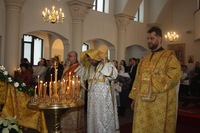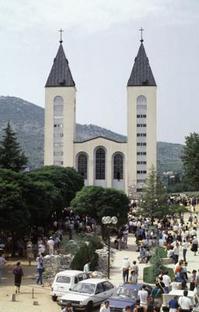The posh Montreal borough of Outremont is dealing with noise complaints against the  Hasidic community by forbidding all outdoor processions — thereby suppressing religious freedom across the board. Next Sunday the Russian Orthodox cathedral in the city will be denied the freedom to carry out its midnight Easter liturgy, which starts with a procession around the church.
Hasidic community by forbidding all outdoor processions — thereby suppressing religious freedom across the board. Next Sunday the Russian Orthodox cathedral in the city will be denied the freedom to carry out its midnight Easter liturgy, which starts with a procession around the church.
Report from Radio Canada International.
Category: Controversies
Vassula just can’t keep out of trouble
Just when one kerfuffle over the automatic-writing mystic Vassula Ryden is announced, along comes another.
Now the Orthodox Church of Cyprus issued a statement about her on January 13. The Synodical Committee for Matters of Heresy —
By the way, isn’t that a great name? Sure, we have a Congregation for the Doctrine of the Faith, which is a nice, positive-sounding name, but some issues really deserve a statement coming from an organization that gets right to the point. This is about identifying, defining, combating and routing heresy. I’ll send a little note to Levada and see if he– well, I’ll do that later.
The Synodical Committee for Matters of Heresy warned:
In reality, her teachings are heretical, and her claims that she communicates directly with Christ are fantastical and outside of the spirit of the experience of the our Church.
So how many Orthodox Churches have issued warnings against her: Greece? Cyprus? The Patriarchate of Constantinople? Does she plan to stop in at church offices to collect the condemnations on her tour?
There are probably more to come!
New York Times Smears (2)
UPDATE (4/6): Please note the correction to this story added below.
It just wouldn’t be Holy Week without a media attack on the Church, would it?
First, a recap for those who haven’t seen much of the story yet: a March 25 NY Times article accused Cdl. Joseph Ratzinger (now Pope Benedict XVI) of shielding a pervert priest from punishment under Church law in 1998.
As John Schultz cited below, a piece for National Review Online by Canadian priest and writer Fr. Raymond de Souza compared the Times’ shoddy article with the documentation it offered as evidence, and showed that the paperwork contradicts the Times’ claims. Moreover, the primary source for Laurie Goodstein’s so-called reporting, the disgraced former Archbishop of Milwaukee Rembert Weakland, has more axes to grind than the crew on American Loggers.
Now an authoritative eyewitness to the case has joined the controversy directly.
Canon-law judge Fr. Thomas Brundage, JCL, who conducted the trial against Fr. Lawrence Murphy, states that neither the Times nor any other media outlet has bothered to contact him to verify any of the facts, or even the statements which the Times presented as quotations from Brundage.
He says that the basic premise of the Times story is wrong: Murphy’s trial was never actually stopped, even up to the day of his death. Without that, the whole trumped-up accusation against Cdl. Ratzinger collapses.
Since the website of the Catholic Anchor newspaper has been swamped with readers today and is currently unable to function, here’s a link to Brundage’s article, reproduced in full in Damien Thompson’s weblog at the Daily Telegraph.
CORRECTION (4/6): Fr. Thomas Brundage has issued a correction about a statement he made in the article cited above. Based on documents, he acknowledges that the trial was indeed stopped by Abp. Weakland, shortly before Fr. Murphy’s death. The point that CDF did not stop the case remains valid.
New York Times Smears
From Father Raymond J. de Souza, a response to the New York Times.
The story is false. It is unsupported by its own documentation. Indeed, it gives every indication of being part of a coordinated campaign against Pope Benedict, rather than responsible journalism.
Mariologist Hauke on Medjugorje: “Don’t let the devotees fall into the void”
 (Translated from the German-language Catholic newspaper Die Tagespost. Thanks to reader budapestinensis for spotting a translation error on my part. The corrected word is marked in red below.)
(Translated from the German-language Catholic newspaper Die Tagespost. Thanks to reader budapestinensis for spotting a translation error on my part. The corrected word is marked in red below.)
(UPDATE 2/9: A Dutch translation of the interview is now available on-line at In Caelo et In Terra.)
(UPDATE 2/18: Translations into other languages are welcome. Bienvenidos, lectores de Panorama Católico internacional.)
(UPDATE 2/22: Fr. Hauke has responded to critics from the Medjugorje movement.)
The Medjugorje phenomenon and the discernment of spirits: a conversation with dogmatic theologian Manfred Hauke
For years there has been discussion of the phenomenon of the alleged “Marian apparitions” that took their origin in Medjugorje: Does the Mother of God really appear to the seers who originated in Medjugorje? Or are the experiences parapsychological fruits of the seers’ unconscious? Are they a deceptive manipulation or even a trick of evil forces? According to reports, there are plans at the Vatican to have the Medjugorje phenomenon conclusively investigated by a commission. Regina Einig asked the chairman of the German Society for Mariology (Deutsche Arbeitsgemeinschaft für Mariologie), professor of dogmatics and patristics at Lugano, Manfred Hauke, about the subject.
Wherein can we find the theological meaning of Marian apparitions?
Appearances of the Mother of God belong to the charism of prophecy, in which the mysterious working of the Spirit of God comes to expression. St. Paul emphasizes: “Do not quench the Spirit! Do not despise prophetic utterances!” (1 Thess. 5:19-20). The book of Proverbs already emphasizes: “Without prophecy, the people become demoralized” (Prov. 29:18). According to Thomas Aquinas, prophetic revelations after the Apostolic era are not given in order to spread a new teaching of faith, but serve to guide human action. Theology speaks here of “private revelations”, inasmuch as the content conveyed does not belong to general and public revelation, which closed with the Apostolic era. “Private”, then, means a reference to an individual person, a group or even the whole Church in a particular historical situation. “Private revelations”, or (better) prophetic revelations help us to recognize the “signs of the times” (Lk. 12:56) and act accordingly. Following Pope Benedict XIV, the recognition of a private revelation by the responsible bishop is not the basis of any duty to believe, in the strict sense (fides divina), but it states that one can approach the apparitions with a purely human faith (fides humana) based on reasoning. So no Catholic is obliged to believe that the Mother of God appeared in Lourdes and Fatima; but the Church states that the reports of the apparitions are worthy of belief and a Catholic may believe in them and cultivate a corresponding spirituality. Yes, the Church has even set several memorial days in the liturgical calendar and issued corresponding Mass formulas. Prophetic revelations are not the normal case of Christian life, but an exception: “Blessed are they who do not see and yet believe” (Jn. 20:29). The Catechism of the Catholic Church stresses with St. John of the Cross: In Jesus Christ, the eternal divine Word, God the Father has shared everything with us (cf. Hebr. 1:1-12). “Any person questioning God or desiring some vision or revelation would be guilty not only of foolish behavior but also of offending him, by not fixing his eyes entirely upon Christ and by living with the desire for some other novelty” (CCC 65).
